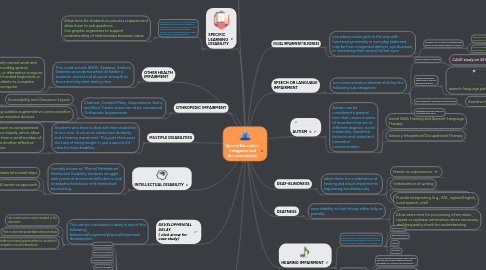
1. TRAUMATIC BRAIN INJURY
1.1. this injury occurs when an external force causes the brain dysfunction or act normally. more specifically, there may be a permanent or temporary impairment of cognitive, physical, and psychosocial functions.
1.1.1. Assistive devices : tape recorders, electronic spellers, computers or word processors, augmentative communication devices, timers, alarms, and beepers or equipment for mobility.
1.1.2. Behavior momentum: has to do with making requests with which the students have a high probability of compliance before making a low-probability request. this allows positive reinforcement to take place.
2. DEVELOPMENTAL DELAY ( click arrow for case study)
2.1. This can be considered a delay in any of the following: behavioral/cognitive/physical/emotional development.
2.1.1. Use visual cues to orient student in the classroom
2.1.2. Post a clear and predictable daily schedule
2.1.3. Provide structured opportunities for student to participate in social interactions
3. EMOTIONAL DISTURBANCE
3.1. This is when a certain characteristic is carried out for a long period of time. It could include a learning disability that is unexplainable. A mood of depression, a habit of developing fears or physical symptoms relating to school problems.
3.1.1. ANXIETY DISORDER
3.1.2. BIPOLAR DISORDER
3.1.3. CONDUCT DISORDER
3.1.4. EATING DISORDER
3.1.5. Post a general class schedule that indicates what students should be expected to do as they enter your classroom, when homework is collected, etc.
3.1.6. Behavior management techniques can be used in the home, school, and community settings.
3.1.7. CASE STUDY:
4. INTELLECTUAL DISABILITY
4.1. Formally known as "Mental Retardation", Intellectual Disability students struggle with practical and social skills due to lack of adaptive behaviour and intellectual functioning.
4.1.1. break down learning tasks into small steps
4.1.2. A hands-on approach
5. MULTIPLE DISABILITIES
5.1. Students who have to deal with two disabilities at one time. Such as an intellectual disability and a hearing impairment. This puts them past the help of being taught in just a special Ed class for their disability.
5.1.1. daptive technologies, such as computerized talkers or tablets. Choice boards, which allow the student to choose from a small number of pictures on a board, are another effective means of communication
6. OTHROPEDIC IMPAIRMENT
6.1. Clubfoot, Cerebral Palsy, Amputations, Burns, and Bone Tuberculoses can all be considered Orthopedic Impairments.
6.1.1. Accessibility and Classroom Layout:
6.1.1.1. VIDEO LINK
6.1.2. Securing suitable augmentative communication and other assistive devices
7. OTHER HEALTH IMPAIRMENT
7.1. This could include ADHD, Epilepsy, Asthma, Diabetes or Leukimia which all hinder a students mental and physical strength to focus and stay alert during class.
7.1.1. Providing ergonomically correct work and computer stations, providing speech recognition software, or alternative compute input devices like one-handed keyboards or switches can help students to complete assignments using a computer.
8. SPECIFIC LEARNING DISABILITY
8.1. This is when a student is not able to read, speak, write, spell or do math equations caused by any number of reasons. It could include brain injury or dysfunction, dyslexia, or not being able to read or hear from sight or hearing impairment.
8.1.1. Allow time for students to process requests and allow them to ask questions. Use graphic organizers to support understanding of relationships between ideas.
9. AUTISM
9.1. Autism can be considered a general term that covers a series of disorders that are of different degrees: social interaction, repetitive behavior and verbal and nonverbal communication
9.1.1. Social Skills Training and Speech-Language Therapy
9.1.2. Sensory Integration/Occupational Therapy
10. DEAF-BLINDNESS
10.1. when there is a combination of hearing and visual impairments happening simultaneously
10.1.1. Hands-on experiences
10.1.2. Verbalization of writing
10.1.3. Adapted equipment for physical education
11. DEAFNESS
11.1. ones inability to hear things either fully or partially.
11.1.1. Provide interpreting (e.g., ASL, signed English, cued speech, oral)
11.1.2. Allow extra time for processing information , repeat or rephrase information when necessary and frequently check for understanding
12. HEARING IMPAIRMENT
12.1. there are 2 kinds of hearing impairment: mild meaning there is difficulty hearing faint or distant speech while severe is when a person may not be able to distinguish any sounds.
12.1.1. CONDUCTIVE
12.1.2. SENSORINEURAL
12.1.3. MIXED
12.1.4. CENTRAL
12.2. accomodation/intervention:
12.2.1. Circular seating arrangements offer students who are deaf or hard of hearing the best advantage for seeing all class participants.
12.2.2. People who are deaf or hard of hearing often use vision as a primary means of receiving information. Captioned videos, overheads, diagrams, and other visual aids are useful instructional tools for students with hearing impairments.
13. SPEECH OR LANGUAGE IMPAIRMENT
13.1. is a communication disorder that has the following sub categories :
13.1.1. Fluency disorder: stuterring
13.1.1.1. CASE study on SETH and fluency :
13.1.2. impaired articulation: where there is difficulty pronouncing words
13.1.2.1. speech-language pathology services:
13.1.2.1.1. CASE STUDY:
13.1.3. voice impairment: difficulty voicing out words
13.1.3.1. Assistive technology (AT)
13.1.4. language impairment: hard time comprehending words
14. VISUAL IMPAIRMENT/ BLINDNESS
14.1. one whose vision gets in the way with functioning normally in everyday tasks and may be from congenital defects, eye diseases, or something that injured his/her eyes.
14.1.1. Blindness: lack of vision or something that cannot be corrected by glasses or lenses.
14.1.1.1. Read aloud using stories and books that are interesting and appropriate for the child.
14.1.1.2. E-text strategies, including tracking, auditory support and refreshable braille;

